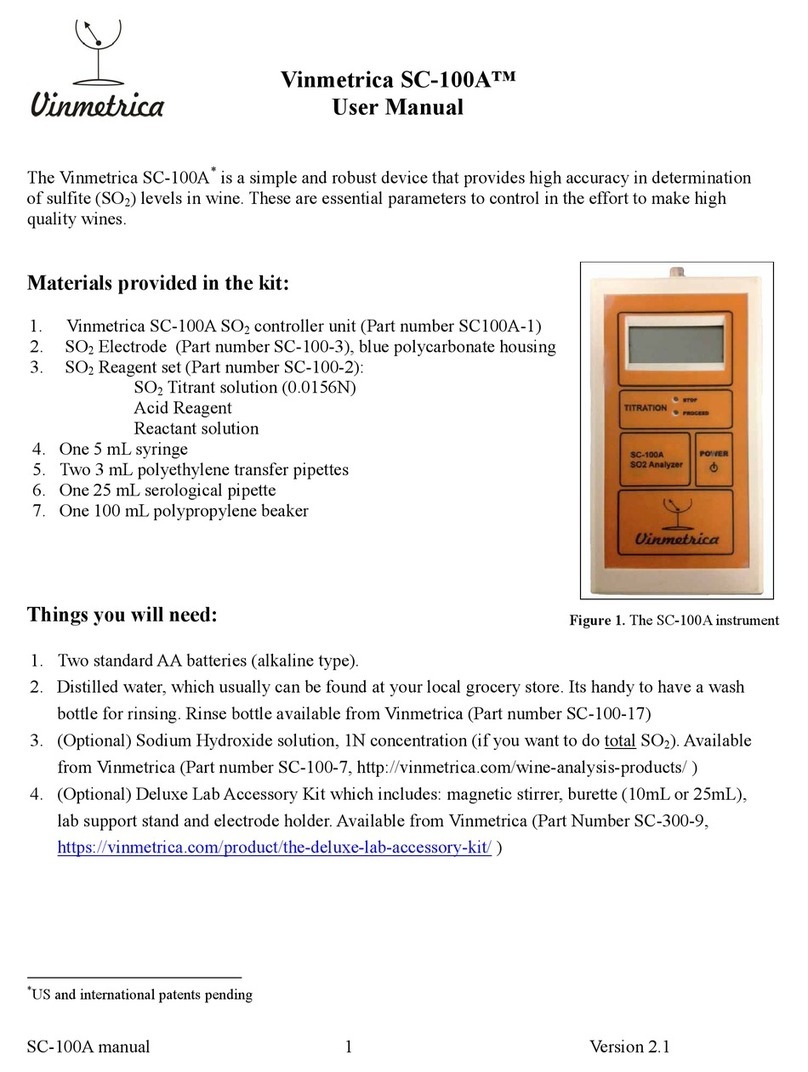
SC-100A manual 5Version 3.1c
solution with an “A” and the pipette for the Reactant solution with an “R”. If they do get
contaminated rinse them off with distilled water and let air dry. Caution: the Acid reagent is
corrosive and can cause damage to clothing, skin and eyes. All of the reagents are not to be
ingested. We recommend use of laboratory safety glasses and latex or nitrile gloves during
this procedure. If any solutions contact skin or eyes, flush with plenty of water.
5. Rinse the electrode briefly with distilled water before inserting it into your wine sample.
6. If you are stirring manually, begin now; use a constant moderate
swirling motion. If the electrode is not held in a stand, hold it against
the side of the beaker with one finger and grasp the beaker with the
remaining fingers so that the two move together. (Figure 7).
7. If you are using the magnetic stirrer, place the bar in the beaker, place
the beaker on top of the magnetic stirrer, and turn the magnetic stirrer
on. Be sure the stir bar will not strike the electrode in the next step.
Insert the electrode into the titration beaker so that the tip is
completely submerged to just above the circulation gaps (cutouts at
the tip of the electrode) but above the level of the stir bar
(approximately a half an inch from the bottom of the titration
beaker). If you are using the Electrode Holder, adjust it to a similar
level. You may add up to 20 mL water if needed.
8. Verify that the current is less than 50 and the green (“PROCEED”) LED is lit. If the current is
greater than this, and/or the red (“STOP”) LED is lit and the buzzer sounds, your sample has less
than 2 ppm SO2 and there is no need to proceed.
9. Titrate the sample by adding the SO2 Titrant dropwise from the syringe or burette (Figure 7), being
sure to note the starting volume mark on the syringe or burette. Try to accomplish the titration as
rapidly as possible (in 3 minutes or less), but be careful near the endpoint so as not to overrun. Be
sure to maintain stirring or swirling throughout the entire procedure.
10. During the titration, the LCD display will show transient currents, the red STOP LED will briefly
illuminate, and the beeper will sound (“beep-beep!”). These transient indicators will last longer
and longer as you approach the endpoint. Take the endpoint as the first addition of Titrant that
causes the display to exceed 50, and the red LED and beeper to stay on, for longer than 15 seconds
(or a count of 20 “beep-beeps”). It is important to maintain stirring or swirling to detect the
endpoint well. Read the endpoint volume off of the syringe or burette. This is your final volume.
11. Calculate the volume of titrant used “V” (using the syringe or burette: Starting volume minus final
volume, e.g.: V = 5.0 mL - 3.5 mL = 1.5 mL).
Figure 7. Manual stirring
technique. Hold the electrode
against the side of the titration
beaker and swirl gently; add SO2
Titrant with other hand.


































